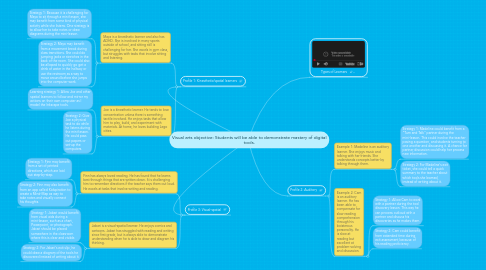
1. Profile 1: Kinesthetic/spatial learners
1.1. Maya is a kinesthetic learner and also has ADHD. She is involved in many sports outside of school, and sitting still is challenging for her. She excels in gym class, but struggles with tasks that involve sitting and listening.
1.1.1. Strategy 1: Because it is challenging for Maya to sit through a mini-lesson, she may benefit from some kind of physical activity while she listens. One strategy is to allow her to take notes or draw diagrams during the mini-lesson.
1.1.2. Strategy 2: Maya may benefit from a movement break during class transitions. She could do jumping jacks or stretches in the back of the room. She could also be allowed to quickly go get a drink of water in the hallway or use the restroom as a way to move around before she jumps into the computer work.
1.2. Joe is a kinesthetic learner. He tends to lose concentration unless there is something tactile involved. He enjoys tasks that allow him to play, build, and experiment with materials. At home, he loves building Lego cities.
1.2.1. Learning strategy 1: Allow Joe and other spatial learners to follow and mirror my actions on their own computer as I model the Inkscape tools.
1.2.2. Strategy 2: Give Joe a physical task to do while he listens during the mini-lesson. He could pass out papers or set-up the computers.
2. Profile 3: Visual-spatial
2.1. Finn has always loved reading. He has found that he learns best through things that are written down. It is challenging him to remember directions if the teacher says them out loud. He excels at tasks that involve writing and reading.
2.1.1. Strategy 1: Finn may benefit from a set of printed directions, which are laid out step-by-step.
2.1.2. Strategy 2: Finn may also benefit from an app called Kidspiration to create a Mind-Map as way to take notes and visually connect his thoughts.
2.2. Jabari is a visual-spatial learner. He enjoys comics and cartoons. Jabari has struggled with reading and writing since first grade, but is always able to demonstrate understanding when he is able to draw and diagram his thinking.
2.2.1. Strategy 1: Jabari would benefit from visual aids during a mini-lesson, such as a chart, Powerpoint, or photograph. Jabari should be placed somewhere in the classroom where this is clear and visible.
2.2.2. Strategy 2: For Jabari's exit slip, he could draw a diagram of the tools he discovered instead of writing about it.
3. Profile 2: Auditory
3.1. Example 1: Madeline is an auditory learner. She enjoys music and talking with her friends. She understands concepts better by talking through them.
3.1.1. Strategy 1: Madeline could benefit from a "Turn and Talk" partner during the mini-lesson. This could involve the teacher posing a question, and students turning to one another and discussing it. A chance for partner discussion could help her process new information.
3.1.2. Strategy 2: For Madeline's exit ticket, she could tell a quick summary to the teacher about which tools she learned, instead of writing about it.
3.2. Example 2: Cam is an auditory learner. He has been able to compensate for slow reading comprehension through his boisterous personality. He is slow at reading but excellent at problem-solving and discussion.
3.2.1. Strategy 1: Allow Cam to work with a partner during the tool discovery lesson. This way he can process outloud with a partner and discuss his discoveries as he makes them.
3.2.2. Strategy 2: Cam could benefit from extended time during exit assessment because of his reading proficiency.

